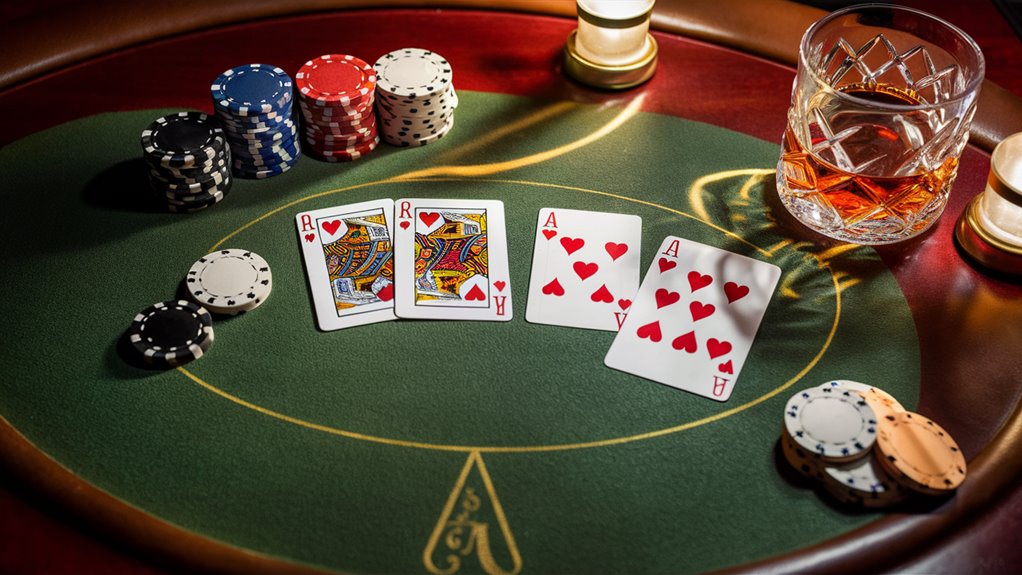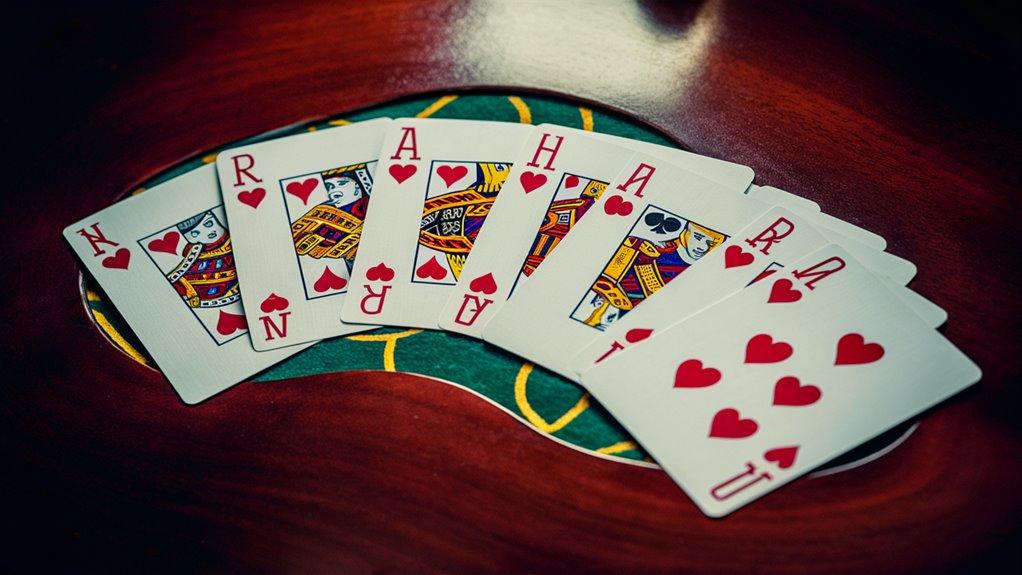
Start with Poker: The Full Book

Poker is one of the most deep card games, mixing skill, mind play, and math. Using a regular pack of 52, players face off to get the top five-card mix, from a single high card to the top royal flush.
Main Game Moves
The heart of poker has four key moves:
- Check: Skipping your turn when no chips are in the pot
- Bet: Adding chips to the pot
- Call: Matching what others bet
- Fold: Giving up your cards
Key Play Tricks
Position is very big in poker. Going last gives a big edge in knowledge, letting you act with more info from what others do. Good players use this edge and change their moves based on their spot at the table.
Math in Play
To win in poker, you need to know:
- Chance math
- How many chips to pot
- Pot odds
- What you expect to win or lose
These math ideas are key to making smart moves, watching foes, and handling tricks. This makes the challenge of high-level poker.
Know Poker Cards: The Full Book
Must-Know Poker Cards from Best to Worst
Knowing poker cards is key to win. These ten card sets stay the same in most poker styles, being at the heart of the game.
Top Cards
The Royal Flush is the best, with five order cards of the same suit from 10 to Ace.
The Straight Flush comes next, with five order cards in the same suit.
Four of a Kind shows four same rank cards, and the Full House mixes three like cards with a pair.
Middle Cards
A Flush has five cards not in order but the same suit.
The Straight needs five order cards, suit not cared for.
Three of a Kind has three like rank cards, while Two Pair has two different sets of like cards.
Basic Cards
One Pair has two like cards, while High Card is for hands without any same cards, ranked by the top card.
Quick Card Spotting
Top players know cards fast, letting them choose quickly during play.
With strong cards hard to get, every hand hold big value. This push and pull of card power and how often they show up is core to poker.
Key Poker Bet Rules
Main Betting Moves
Betting parts are key to play, just like card orders.
The four main bet moves are:
- Check: Pass when no bet is there
- Bet: Put chips in the pot
- Call: Match a bet
- Raise: Add to the bet
- Fold: Drop your hand
Bet Setup and Blinds
Must-bet rules make the start pot through small and big blind bets.
These needed bets set the base for bet rounds in Texas Hold’em.
Players have to meet or beat past bets to stay in the hand.
Spot and Bet Tops
Table spot gives key edges, with late spots giving better info.
Limits on betting are:
- Low bet: Often the big blind amount
- Top bet: Changes by style
- Limited games: Set bet sizes
- Pot-limited: Bet up to pot size
- No-limited: Bet any amount of your chips
Starting with limit poker is good for new players before moving to more open no-limit styles, where bets can be any size.
Table Spots in Poker: A Key Guide

Why Spot Matters in Poker
Table spots are key in poker, changing every choice at the table.
The dealer button moves each hand, setting the order of play and shaping game edges.
How Spots and Moves Link
The bet order starts left of the dealer, making clear spot edges.
Players in early spots (EP) pick with less info, while those in late spots (LP) act after seeing what others do.
This knowledge edge makes late spot play more likely to win over time.
Names and Setup of Spots
Usual Table Form
Most poker tables fit 6-10 players, with 9-hand games common in casinos.
Each spot has its own play meaning:
- Small Blind (SB): First must-bet spot
- Big Blind (BB): Second must-bet spot
- Under the Gun (UTG): First to go after blinds
- Hijack (HJ): Two before button
- Cutoff (CO): One before button
- Button (BTN): Best spot
Knowing these spot links and changing your game to fit can help you win more and do well in poker.
Top Foe Spotting in Poker
Seeing What They Do
Spotting foes right sets top players apart from the rest.
Winners watch how much others bet, when they move, and how they act to guess their cards.
When foes bet the same with strong hands, this known move can be used to decide what to do.
Guessing from Time
Time-based choices give hints on what cards foes hold.
Fast moves often mean they are sure and have strong hands, while slow thinking may show they are unsure or thinking hard.
Getting these time hints can help you make big moves, mostly in big games.
Deep Foe Study
Deep tracking of how foes play means looking at how they play in many setups. Key things are:
- How they use their spot
- How often they go big
- How they handle top hands
- How much they bluff
- How they deal with stress
Mixing these hints on acts with strong poker know-how lets players use foes’ weak spots while dodging their strong moves.
This planned way to profile players helps make better choices and up your wins through poker games.
Top Poker Types: A Full Book
Most Played Poker Games
Texas Hold’em is the top poker type, seen most in casino rooms and online.
Players get two private cards and use five shared cards to make their best hand. The deep play and easy reach of Hold’em have made it the main poker type around the world.
More Poker Types
Omaha poker is another cool type, giving players four private cards but they must use just two with three shared cards 온카스터디 안전업체 보기
This set-up leads to more possible hands and deeper play than Hold’em, pulling in those who want more tests.
Seven-Card Stud is an old style with no shared cards. Players get seven cards through many betting rounds, some open and some not. This old style checks memory and watching skills while needing sharp card reading Splits Into a Grand Dealer Upset
Quick Poker Games
Five-Card Draw offers fast fun, great for easy games and learning the basic moves. Getting five cards with a chance to change shows simple play perfect for starters.
Special Types
Razz and Hi-Lo formats bring new win ways where the lowest hand might win. These types need players to know different card orders and use special game ways unlike the usual high-hand poker games.
Game Ways to Think On
Each poker type needs its own play ways:
- Hold’em focuses on spot and reading shared cards
- Omaha play needs careful card picking and top hand needs
- Stud types reward sharp tracking of open cards and watching foes
- Draw poker wins need good card change choices and tricking foes


